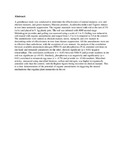| dc.description.abstract | A greenhouse study was conducted to determine the effectiveness of animal manures, cow and chicken manures, and green manures, Mucuna pruriens, Azadirachta indica and Tagetes minuta in root knot nematode suppression. The organic materials were mixed with soil at the rate of 5% (w/w) and placed in 5- kg plastic pots. The soil was infested with 4000 second-stage Meloidogyne juveniles and galling was assessed using a scale of 1 to 9. Galling was reduced in soil treated with organic amendments and ranged from 1.5 to 4.4 compared to 5.8 in the control. The amendments were ranked as chicken manure, neem, marigold, and cow manure in descending order of effectiveness in root-knot disease suppression. All the amendments were mo re effective than carbofuran, with the exception of cow manure. An analysis of the correlation between available ammonium nitrogen (NH4-N) and phosphorous (P) in amended soil done on one hand and nematode parameters on the other, showed significant (p < 0.01) negative relationships. The correlation coefficient (r = -0.85) between NH4-N and juvenile numbers in the soil was significant (p < 0.01). Similarly, phosphorous was negatively and significantly (p < 0.01) correlated to nematode egg mass (r = -0.79) and juvenile (r= -0.44) numbers. Microbial activity, measured using microbial biomass, carbon and nitrogen, was higher in organically amended soils than the control, with the highest figures being recorded on chicken manure. This is a clear demonstration of the potential of organic amendments in triggering the natural mechanisms that regulate plant nematodes in the soi | en |

